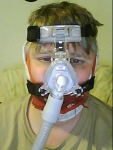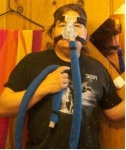StillAnotherGuess wrote:
PS Min and PS Max are two different animals..
Keep repeating the mantra until it sinks in:
CPAP therapy: PS Min = 0
Bilevel therapy: PS Min > 0
ASV therapy: PS Max > 0
Wrong, wrong, wrong and also, wrong. (Yes, that's 4 wrongs -- one for the initially silly statement, and three for the next three necessary but not by-themselves-sufficient conditions.)
First off, let's clarify a definition, shall we? In Respironics language, PS (pressure support) is defined as the difference between IPAP and EPAP. If you set Min PS > 0, you are enforcing the constraint that
some bilevel support will be employed -- i.e., IPAP will always be larger than EPAP. Max PS specifies the maximum bilevel support the ASV will attempt. I have seen the term "pressure support" used in various literature in different ways, but with respect to a Respironics device, this is what it means.
This is the second time in this thread that you have insisted (incorrectly) that "PS Max > 0" is "ASV therapy." Putting aside the obvious issue that nearly all ASV users employ a backup rate, the condition as specified is
still not sufficient. Let's start be creating a random variable
x, and specifying that PS Min = PS Max =
x, where
x > 0. The implications of that, ignoring ramping, are as follows:
- The user's ASV will run in the equivalent of automatic bilevel mode
- The difference between IPAP and EPAP will always be static (equal to x), and EPAP and IPAP will increase or decrease concomitantly and by the same absolute values
- The maximum possible IPAP is constrained by the lesser of either Max EPAP + x or Max Pressure
- The maximum possible EPAP is constrained by the lesser of Max Pressure - x or Max EPAP
- The minimum possible IPAP would be min EPAP + x
To put these equations into an example, let's set
x to 4 and specify the remaining variables as follows, preserving that condition: Min EPAP = 8, Min PS = 4, Max PS = 4, Max EPAP=15, and Max Pressure = 30. Under these parameters, possible pressures (when not ramping) would be 12/8, 13/9, 14/10,..., 19/15. IPAP will always equal EPAP + 4. Note how constraining Max PS to 4 means that there would be no functional difference at all between setting Max Pressure = 19 and setting Max Pressure = 30.
Similarly, PS Min > 0 is not a sufficient condition for straight traditional bilevel therapy either. If PS Min =
x > 0 and PS Max > PS Min, IPAP will again be allowed to vary, but it will always exceed EPAP by an amount greater than or equal to
x. Let's pretend this time that Min EPAP = 8, Min PS = 4, Max PS = 15, and Max Pressure = 30. (Note the only difference from my preceding example is that I have specified Max PS = 15). Some possible pressures (again not while ramping) would include 12/8, 13/8, 14/8, 13/9, 14/9, 14/10, 15/10, etc. The maximum possible pressure combination would be 15/30, and the minimum IPAP given that maximum EPAP would be 19/15. Bilevel always? Yes. Static difference between IPAP and EPAP, as most BiPAP and Auto-BiPAP users see? Nope.
And while I'm at it, PS Min = 0 is also not a sufficient condition for CPAP mode. A great many of us run our ASVs with PS Min = 0, including myself when using a FFM. All that does is permit the ASV to
try IPAP = EPAP. It does not prohibit IPAP from exceeding EPAP. IPAP and for that matter EPAP can both bounce around, constrained of course by Max Pressure, Max PS, and Max EPAP. Setting PS Min to 0 by itself prohibits neither bilevel nor ASV therapy.
StillAnotherGuess wrote:
I imagine the RTs screwed up when they set-up your new machine. They probably wanted to set PS MIN = 4 and PS Max = 0, but they got it transposed.
WTF? I'm not sure where you got the idea that Max PS can be less than Min PS, but once again, wrong. In addition to failing a basic common sense check, I tried to see if my ASV would let me do that. It doesn't. Score a victory for the little man and common sense.












